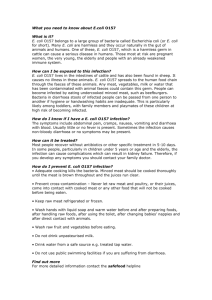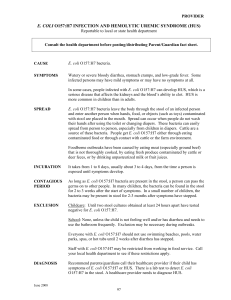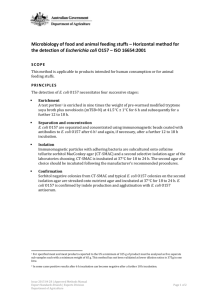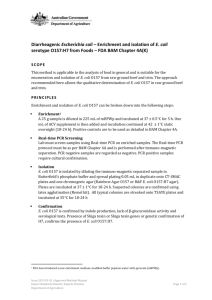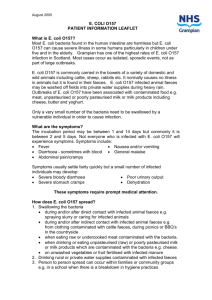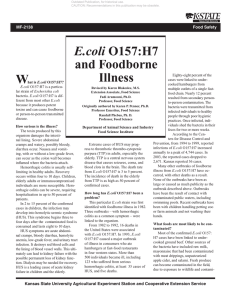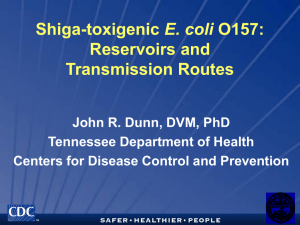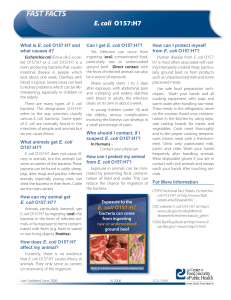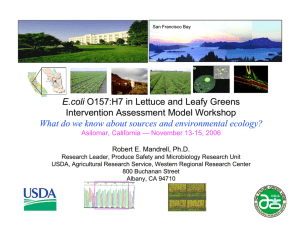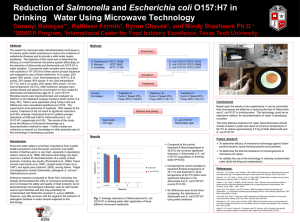final_case_study_slides case 63 - Cal State LA
advertisement
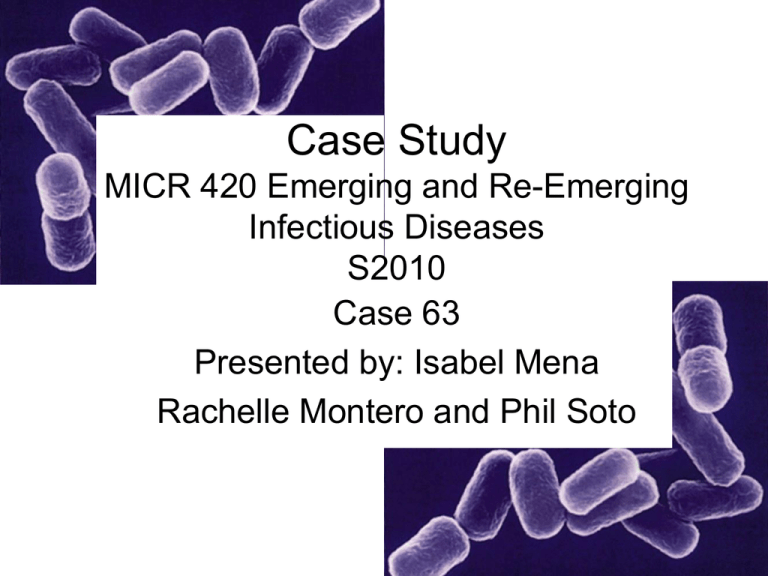
Case Study MICR 420 Emerging and Re-Emerging Infectious Diseases S2010 Case 63 Presented by: Isabel Mena Rachelle Montero and Phil Soto Case Summary • 8 year old male • Symptoms: 2 days of diarrhea (worsening, 14 movements that day, bloody), dehydration, pain on defecation, vomited once • History: 6 days before he attended a cookout where he ate a burger that was pink inside • Labs: • significant white blood cell count • polymorphonuclear cells in methylene blue stain of feces • positive stool guaiac- a test for blood in feces Key Information Pointing to Diagnosis Patient presents with: • Bloody diarrhea • History of ingesting uncooked meat 6 days previous to hospital admittance Laboratory Tests: • MacConkey-Sorbitol stool culture The Diagnosis for Case 63 Hemorrhagic Colitis caused by E. coli O157:H7 Microbiology E. coli O157 H7 • E. coli is a gram negative bacillus of the enterobacteriaceae family: – Motile – Fermentor – Facultative anaerobe • E. coli are a part of the human normal microbiota and only a few strains are pathogenic • Pathogenic strains are identified through serotyping by the Flagellar antigen (H-antigen) and the O-chain on LPS (O-antigen) as well as the capsular antigen (K-antigen) • Virulence Factors: – – – – Pili: attachment Capsules: prevent phagocytosis Endotoxin (LPS): Overproduction of cytokines Enterotoxins: various kinds diarrhea • E. coli O157 H7 is classified as Enterohemorrhagic – produces the Shiga-like toxin – sorbitol negative Pathogenesis of E. coli O157: H7 Image courtesy of Helmholtz Association of German Research Centres Pathogenesis cont. • Image courtesy of nature.com Mohawk K.L. et al. 2010. Microbial Pathogenesis, vol 48:131-142 • The experiment used mice with intact normal flora and infected them with E. coli O157:H7 either orally or by intragastric administration. – Infection by E. coli first begins in the cecum where it colonizes and then the toxin passes into the blood stream – Intimin is a major virulence factor involved in attachment to epithelial cells and toxins are released upon attachment Representative Figure Diagnostic Tests for E. coli O157:H7 • Stool cultures using Sorbitol MacConkey (SMAC) agar • On SMAC agar O157 colonies appear clear due to their inability to ferment sorbitol, whereby the common E. coli is presented by a normal flora. • Stool guaiac test – Hydrogen peroxide (oxidizes the guaiac) – Positive indicated by color change • Cytotoxicity assay • The newer method is detecting the O group by PCR Therapy and Prognosis for E. coli O157:H7 • Supportive care – Hydration – electrolytes • Monitor renal function, hemoglobin, and platelets closely. • Renal replacement therapy – Dialysis or kidney transplantation • According to CDC studies indicate that antibiotics may promote the development of HUS. Prevention of E. coli O157:H7 • Tighter inspections of the manufactures. • Stop, look and think before you eat your next meal. Epidemiology – Major sources are spinach and undercooked ground beef. – Easily spread from person to person Threats – Estimated 73,000 cases annually in US; 2,100 hospitalizations, 61 fatal cases – Hemolytic Uremic Syndrome in children and elderly – Nationally reportable – Other strains of E.coli are producing Shiga-like Toxins What do we tell the patient: • We notify the parents that the test results for their son indicate that he has hemmorhagic colitis caused by E. coli O157:H7 • Most likely caused by the uncooked burger he consumed 6 days ago • We will keep him under observation for 24hr and treat him with trimethoprimsulfamethoxazole and fluids for his dehydration • If improvements are shown during that time you will be able to take him home. Take Home Message • Hemmorhagic colitis involves infection by the bacteria E.Coli. O157 H7 • Typical symptoms are diarrhea, blood in feces and dehydration. • Diagnostics include a culture of stool specimen on MacConkey sorbitol agar and a stool guaiac test. • Therapy is based on supportive therapy: fluids and electrolytes • Prognosis could be fatal if HUS develops • Prevention is to be aware of food before ingesting • Transmission is most commonly through food (ex. spinach and undercooked meat) References • http://www.cdc.gov/mmwr/preview/mmwrhtml/rr5304a1.htm • http://www.fda.gov/food/foodsafety/foodborneillness/foodborneillnes sfoodbornepathogensnaturaltoxins/badbugbook/ucm071284.htm • http://www.sciencedaily.com/releases/2009/03/090319102311.htm • http://www.nature.com/nrmicro/journal/v8/n1/fig_tab/nrmicro2265_F 2.html • http://www.cdc.gov/ecoli/ • Micr 420 Lecture 6 Dr. Nancy McQueen and Dr. Edith Porter 2010
